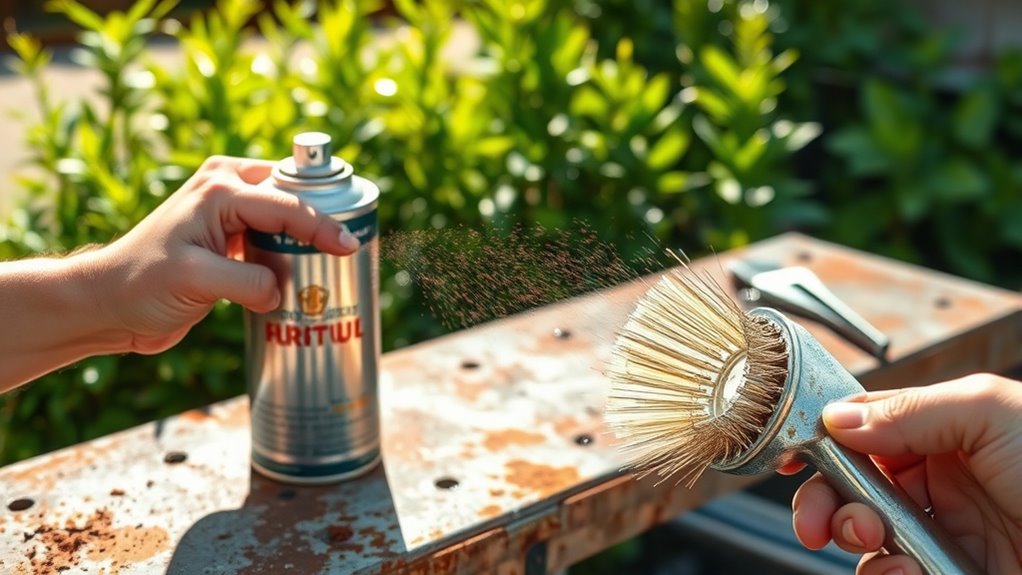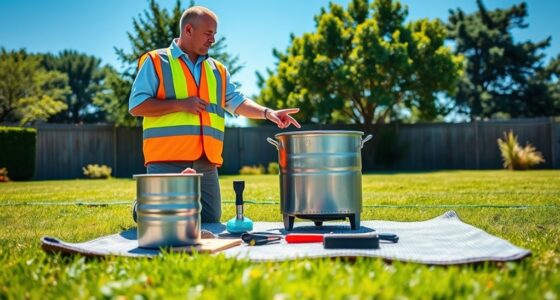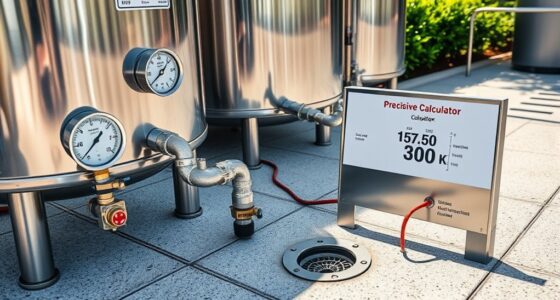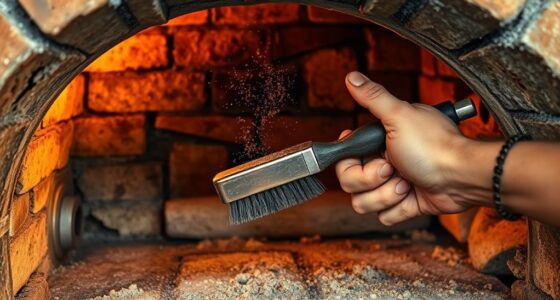In just 15 minutes, you can prevent outdoor rust by first cleaning the metal surface thoroughly with a wire brush or sandpaper to remove dirt and loose rust. Then, apply a rust-inhibiting primer or sealant to create a barrier against moisture. Store your items in a sheltered place if possible and reapply coatings regularly to maintain protection. Keep going to uncover more simple, effective steps to keep rust at bay long-term.
Key Takeaways
- Clean rusted areas with a wire brush or sandpaper to remove loose rust and debris.
- Apply a rust converter to stabilize existing rust quickly and create a paintable surface.
- Use a high-quality, rust-inhibiting primer or spray coating designed for outdoor use.
- Cover the item with a protective sealant or outdoor paint to block moisture access.
- Store items indoors or under cover to prevent further moisture exposure and rust formation.
Simple Strategies to Prevent Outdoor Rust
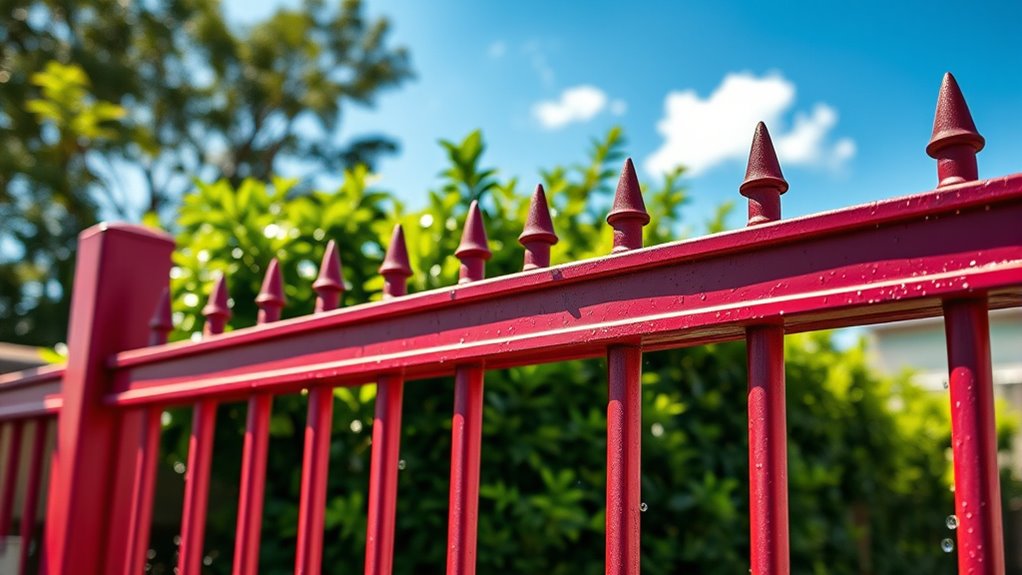
Outdoor rust can quickly damage your equipment and belongings if you don’t take steps to prevent it. Rust weakens metal over time, leading to costly repairs or replacements. One of the most effective ways to combat rust is by enhancing corrosion resistance through the application of protective coatings. These coatings act as a barrier, preventing moisture, oxygen, and other corrosive elements from reaching the metal surface. When you choose the right protective coatings, you markedly extend the lifespan of outdoor equipment, furniture, or tools, saving you both time and money in the long run.
Applying protective coatings is key to preventing rust and extending outdoor equipment lifespan.
Start by inspecting your items regularly to catch early signs of rust or damage. Clean off dirt, mud, and existing rust using a wire brush or sandpaper, making sure the surface is smooth and free of loose particles. Once cleaned, apply a high-quality rust-inhibiting primer or protective coating designed specifically for outdoor use. These coatings are formulated to adhere well to metal surfaces, providing excellent corrosion resistance. If you’re working with tools or equipment that will be exposed to harsh weather, consider using paint or sealants that contain rust inhibitors, which can further improve their durability.
For added protection, consider treating your metal surfaces with a galvanizing process, especially if they’re frequently exposed to moisture. Galvanization involves coating the metal with a layer of zinc, which offers superior corrosion resistance and acts as an extra shield against rust. If you’re not ready for galvanizing, a simple spray-on rust converter can be useful for already rusted areas, transforming rust into a stable, paintable surface that resists further corrosion. Additionally, consistent use of corrosion-resistant materials when selecting new outdoor equipment can prevent rust from developing in the first place.
Another quick win is to keep your outdoor metal items dry whenever possible. Use covers or store them in sheltered areas during heavy rain or snow. When you can’t store items indoors, applying a protective coating before outdoor use is vital. Regular maintenance, like reapplying coatings or touch-up paint, will help sustain their resistance to rust, especially in climates with high humidity or salt exposure near coastal areas.
Finally, consider the environment where you keep your belongings. Reducing exposure to moisture and salty air goes a long way in preventing rust. Combining these practices—using protective coatings, ensuring proper storage, and maintaining your items—will greatly improve their corrosion resistance. By taking these quick, proactive steps, you’ll shield your outdoor assets from rust and keep them in top condition longer, saving you headaches and expenses down the line.
Frequently Asked Questions
Can Rust Prevention Methods Be Environmentally Friendly?
Yes, rust prevention methods can be eco-friendly. You can choose eco-friendly coatings that are free from harmful chemicals, ensuring they don’t harm the environment. Additionally, biodegradable rust inhibitors break down naturally over time, reducing pollution. By selecting these options, you effectively protect your outdoor metal items while minimizing your environmental impact. It’s a responsible way to prevent rust without compromising the health of our planet.
How Long Does Rust Prevention Coating Last Outdoors?
If you apply a high-quality rust prevention coating, it can last outdoors for 3 to 5 years. For example, a metal fence treated with a durable epoxy coating showed impressive rust durability, maintaining its protection for nearly five years despite harsh weather. The key to maximizing coating longevity is proper surface preparation and choosing eco-friendly products. Regular inspections can also help extend the lifespan of your rust prevention efforts.
Are DIY Rust Prevention Solutions as Effective as Commercial Products?
DIY solutions can be effective for rust prevention, but they typically don’t match the commercial effectiveness of professional products. You might find homemade remedies like rust converters or protective paints useful for small projects or temporary protection. However, for long-lasting, reliable results, investing in commercial rust prevention coatings is smarter. They’re designed specifically for durability outdoors, ensuring better protection against moisture, corrosion, and environmental factors that DIY solutions might not withstand over time.
What Are the Best Storage Options to Minimize Outdoor Rust?
You should opt for weatherproof storage options like metal cabinets or plastic containers with tight seals to minimize outdoor rust. Before storing, treat your tools and equipment with a protective coating or rust inhibitor to prevent corrosion. Using metal treatment products enhances durability, and ensuring your storage is weatherproof keeps moisture out. Regularly inspect and maintain your storage to catch and address any rust early, safeguarding your gear effectively.
How Often Should Outdoor Metal Objects Be Inspected for Rust?
Think of your outdoor metal objects like a garden plant; they need regular attention. You should inspect them at least once a month, especially during rainy or humid weather, which accelerates rust. Frequent inspections help catch rust early, like spotting weeds before they take over. Adjust your inspection frequency based on weather conditions—more often during harsh seasons—to prevent rust from taking hold and extend the lifespan of your metal items.
Conclusion
By taking just 15 minutes today, you’re planting seeds of protection that will flourish over time. Think of rust as a sneaky invader—you hold the power to block its path with simple, quick actions. Like a shield that stands firm against the storm, your efforts today fortify your outdoor treasures, ensuring they shine bright and resist decay. Remember, small acts of care today build a fortress that keeps rust at bay for years to come.
